More about: Budapest in 1 Day: a guidebook for getting the most out of your visit
If you have a long layover, a day off after a business conference or just find yourself in Budapest for 24 hours, you can make the most of it by following our itinerary.
Ah! And if you don't feel like walking too much, you can always opt to book the Budapest sightseeing bus or a cruise on the Danube. You can even book a guided tour of Budapest to see the must-see sights in a short time.
1. Start the route at the symbol of Hungary
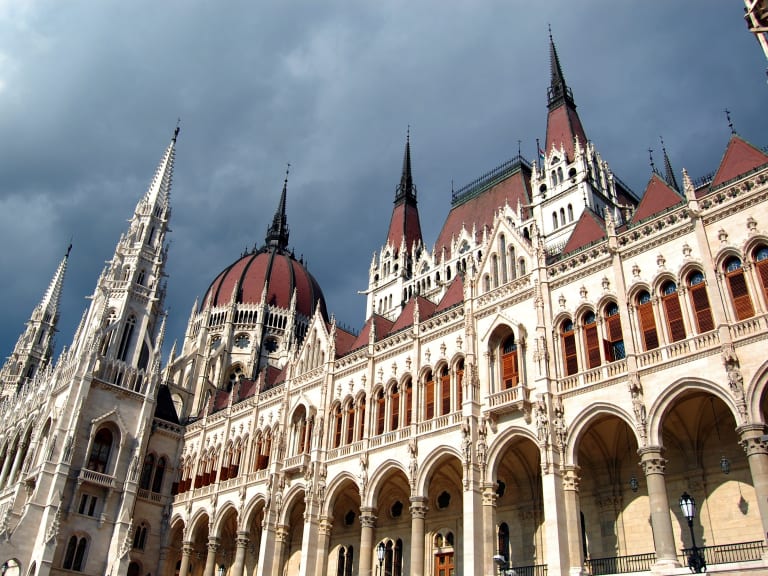
The Parliament of Budapest is the icon of the city. Its external appearance is reminiscent of the Palace of Westminster in London and this is no coincidence, because in 1881 the Hungarian National Assembly issued a call for the project of this building and won the proposal of Imre Steindl because it paid tribute to the British parliament.
In this way they wanted to send a double message: to underline Hungary's commitment to Western Europe and to wink at England, a country taken as a model by the Hungarian reformers.
I recommend you to hire a guided tour of Budapest and the Parliament accompanied by a guide to see inside the building and learn the most interesting anecdotes. During the walk you can admire rooms like the Dome Hall and other important parts of the city.
2. Pay tribute to the victims of the Nazi persecutions

A short distance from the Parliament, a unique monument reminds us of the darkest era of Budapest: the shoes on the banks of the Danube. Molded in iron, these shoes reproduce the models used in the forties and that were abandoned by their owners in this same place.
Next to them, a metal plaque bears the words: "To the memory of the victims shot on the Danube by Arrow Cross militiamen in 1944-45". The Arrow Cross was a party that took power in 1944 when the Germans invaded Hungary.
The Arrow Cross was inspired by the Nazi regime and played a key role in the oppression of the Jewish people. It committed brutal crimes, for example, forcing its prisoners to approach the banks of the Danube and take off their shoes and then shooting them mercilessly. The lifeless bodies ended up directly in the water.
3. Enter the largest church in Hungary
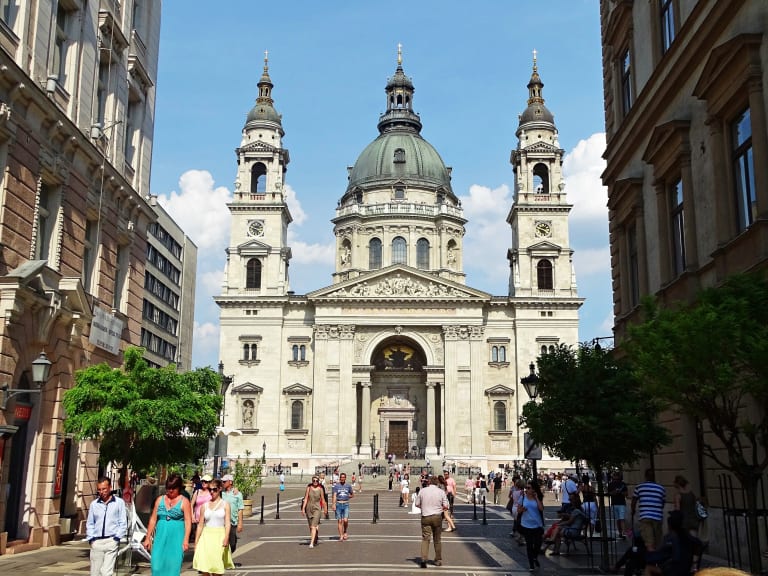
St. Stephen's Basilica (Szent István bazilika) is located a little away from the riverside. To get to its facade you must leave the bank of the Danube, cross Freedom Square (Szabadság tér) and walk along Hercegprímás Street. In about five minutes you will reach the place of worship dedicated to the patron saint of Hungary: St. Stephen.
The austere appearance of the exterior hides a neoclassical interior with red marble columns, gilded details and white stone statues. The origin of the temple is linked to the flooding of Pest. In 1838, the Danube left its course and the inhabitants had to take refuge on a hill where a small church was located.
When the river flood ended, the survivors donated money to build a larger place of worship. If you visit Budapest in December you can enjoy classical music concerts hosted inside.
4. Cross the threshold of the Great Synagogue
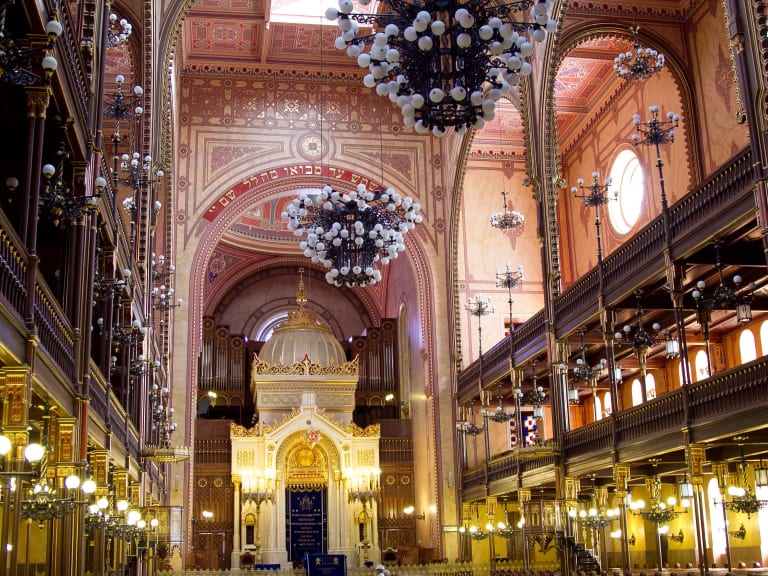
Before entering the Great Synagogue (Dohány utcai zsinagóga), take a few minutes to see the Tree of Life (a metal weeping willow tree with the names of Holocaust victims inscribed on each leaf) and the Jewish cemetery. However, the most surprising thing is hidden inside.
As you enter, look up to see its richly decorated ceiling. Like jewels, two oversized chandeliers embellish and illuminate the central nave. Unlike the other synagogues, the one in Budapest includes elements more typical of Christianity: the rose window, the altar and the pulpits on the side.
Its history is linked to the events of the Second World War. The temple was bombed and then converted into a radio station and then into a stable used by German troops.
Traveller Tip
If you return to this area at the end of the day, note that two streets away is the Szimpla Kert, the dean of the ruin bars in Budapest. The establishment has been a landmark in the Hungarian city since 2002.
5. Take a break at the Central Market
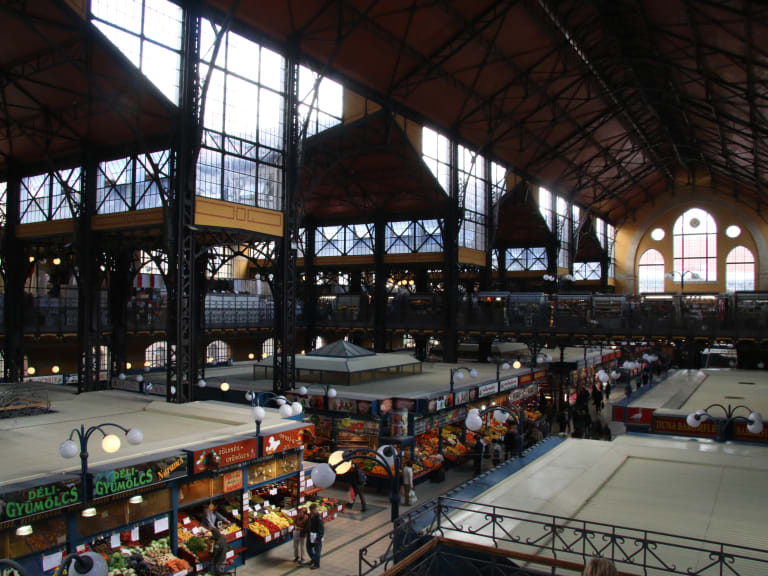
After visiting the Great Synagogue, it's time for lunch. Leave the temple and follow the signs for the Hungarian National Museum (Magyar Nemzeti Múzeum). Once in front, continue along Kálvin tér street and Vámház krt street: in about 15 minutes you will arrive in front of the art nouveau facade of the Central Market.
The building was inaugurated in 1897 and is characterized by its iron structure and elegant yellow, green and red tiles. This covered space is divided into three floors:
- The first is occupied by stores selling fruit, vegetables, meats and other local products.
- The second floor is dedicated to the restaurant where you can taste two emblematic dishes of the country: goulash and lángos.
- The basement houses fishmongers.
Take the opportunity to do some shopping
After lunch, you can finish off the visit with a bit of shopping. The Central Market is the ideal place to buy some souvenirs:
- Paprika, the key ingredient of Hungarian cuisine. The vermilion-colored spice is obtained by crushing dried peppers. There are now two varieties: édes (sweet) and erős (hot).
- Tokaji, a white wine harvested in the north of the country.
- Libamáj, the Hungarian foie gras. Unlike its French counterpart, it is much cheaper! (and no less tasty for that).
- Hungarian embroidery AS tablecloths, napkins and other textiles decorated with floral motifs and bright colors.
- Kolbász, the delicious local sausages.
6. Enjoy the best view of Budapest

To reach the next stage you must cross the Freedom Bridge (Szabadság híd) and climb to the top of Mount Gellert. At the top is the Citadel, a fortress built by the Habsburgs in the first half of the nineteenth century.
This defensive structure has never been used for war purposes and survived the will of the Hungarian people who wanted to destroy it after the end of the First World War. Today, it is a tourist attraction and its bunker is decorated with old photographs and wax figures recreating scenes from the past.
However, most travelers come here to enjoy the view. From here you can see the Danube, the Chain Bridge, the Parliament, St. Stephen's Cathedral and Buda Castle. I also recommend a walk to the Statue of Liberty (Szabadság Szobor).
7. Admire the Budapest Castle
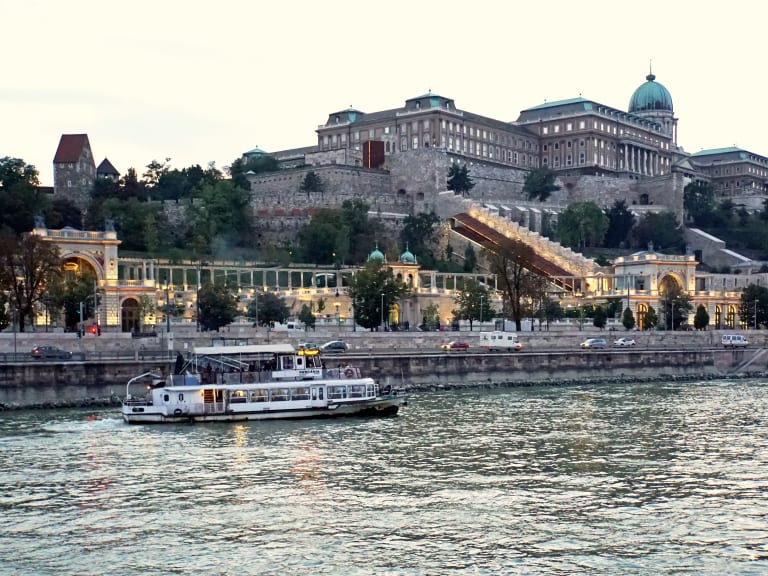
A thirty minute walk will take you to the foot of the building that has guarded the capital for centuries: the Budapest Castle. The first fortress was built in the thirteenth century when King Bèla IV decided to build a fortress to protect himself from Mongol attacks.
However, it was destroyed on several occasions and the construction that we can see today is due to the restructuring carried out by István Janáki in 1950.
Today, this gigantic building houses the National Gallery, the Budapest History Museum and the National Library. Outside, you will see a facade of more than 300 meters (divided into two wings by the central dome) and Turul, a bronze bird of prey portrayed in the act of soaring in flight.
8. Stand in awe at the foot of the Matthias Church

Personally, Matthias Church (Mátyás-templom) is the most beautiful church in the Hungarian capital. Its history is linked to the vicissitudes of the royal family: it was built at the behest of King Bèla IV in the 13th century, hosted the marriage of Emperor Franz Joseph I and his wife Elisabeth (Sissi) and saw the coronation of Charles IV, the last king of the Habsburg dynasty.
Its most curious elements are the colorful majolica tiles, the two towers and the equestrian statue of St. Stephen that guards the facade. If you want to have a drink, you can enjoy a piece of cake or an espresso in the Café Walzer.
9. Take the best pictures from Fisherman's Bastion
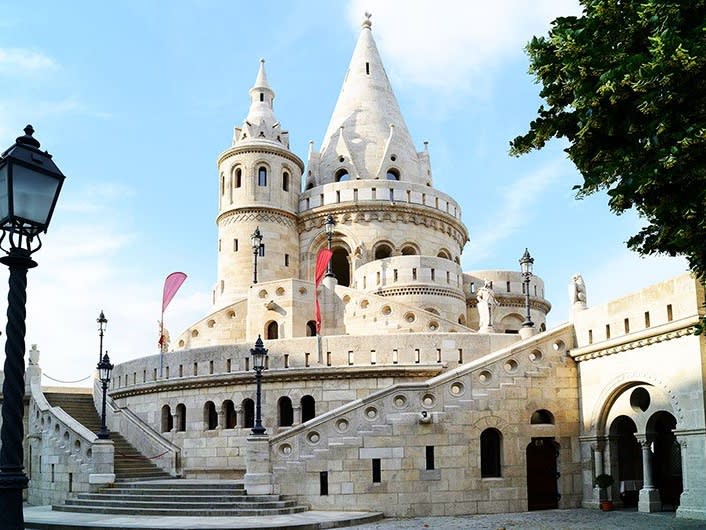
A few meters from this temple is the penultimate stage of the day: the Fisherman's Bastion (Halászbástya). The building bears the signature of the Hungarian architect Frigyes Shlek who designed a structure that mixes neo-Gothic and neo-Romanesque.
In its early years it had a defensive function as it overlooks the Danube, the Chain Bridge and Pest. Today, it is a belvedere where you can take some wonderful pictures.
10. End the day in a restaurant with a view

Right on the terrace of the Bastion is a romantic and exquisite establishment- Halászbástya. The restaurant opened its doors in 2010 and has since become a favorite destination for couples and bon vivants.
Chef Szabó Barna proposes a menu based on seasonality and reinterpreting dishes from tradition.
The reviews speak for themselves: Halászbástya is highly regarded for its comforting soups, duck-based recipes and delicious desserts. From the top of the bastion, you will enjoy an incomparable panorama over the Danube and the Hungarian capital.
Is it worth visiting Budapest in one day?

If I have to be honest, I consider that to explore the Hungarian capital without rushing it is better to opt for a 3-day tour of Budapest.
Budapest has a rich history, having been conquered by the Ottomans over the centuries, having led an empire together with Vienna and having been occupied for more than fifty years by the Soviets. However, the route we have prepared brings together the essentials that can be a snack before your next visit.
What to do in Budapest if it rains?
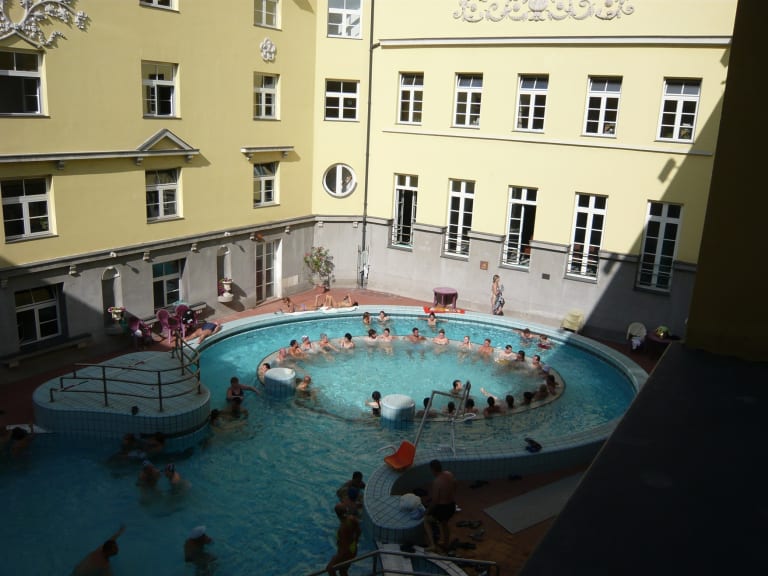
September in Budapest is a very good month to travel to the city. But if you visit at another time and in rainy season, you should know that bad weather is not a good excuse to stay in the hotel.
The Eastern European city has a few attractions that can be enjoyed even if it rains or snows. In addition to some of the attractions already mentioned, there is much more to see! In the list below you will find some very interesting options:
- Thermal baths, a must-see in Budapest. If you want to find the destination you like the most, I recommend you to read the post about the best spas in the city. But undoubtedly, the most recommended is to book tickets to the Széchenyi Spa.
- Millennium Underground: it is the museum that commemorates the first subway railroad of the continent. In fact, Budapest was the second city in the world to have a subway line. It occupies an abandoned section of the tracks and has some old subway cars.
- Rock Hospital Museum: it is a labyrinth of subway chambers. Here the inhabitants of the city took refuge during World War II. With the arrival of the Soviets, it was converted into an anti-atomic bunker.
- House of Terror Museum: it is the former headquarters of the political police both during the Nazi occupation and during the communist regime. In its interiors you can discover how life was lived during the bloodiest dictatorships in Europe. The highlight is the Soviet T54 tank used to suppress the Hungarian uprising of 1956.




